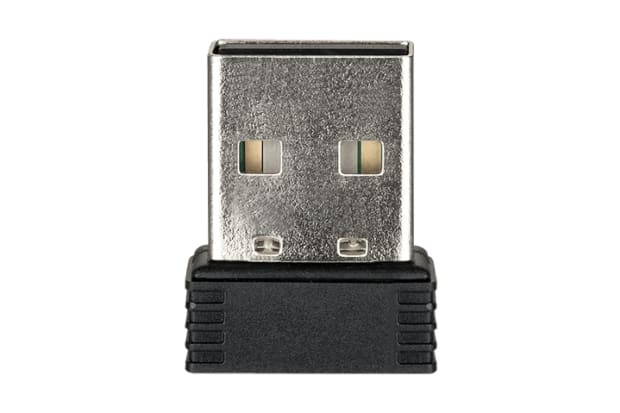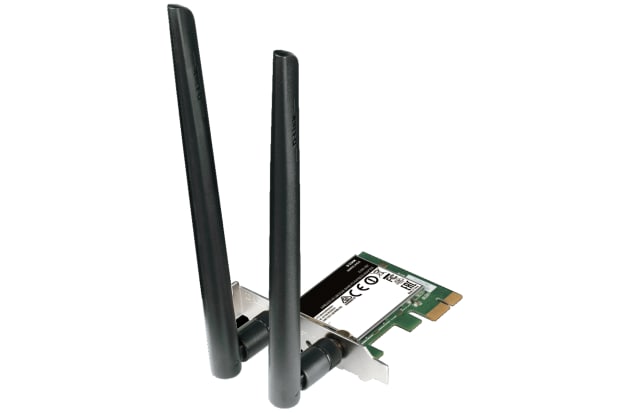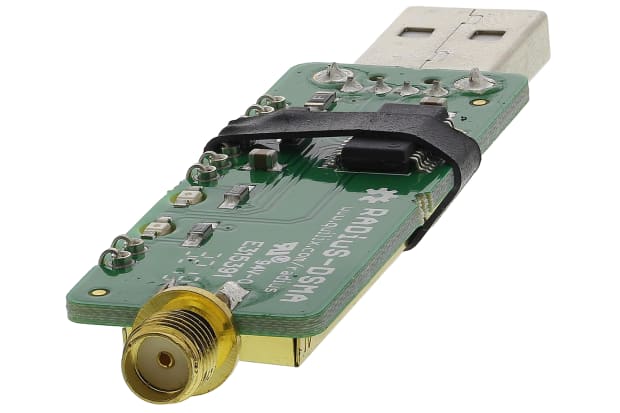- Published 24 Jan 2023
- Last Modified 29 Aug 2023
- 9 min
A Complete Guide to Wireless Adapters
Our wireless adapters guide explains their uses, how they work, the different interface types, and more.

What is a Wireless Adapter?
Wireless adapters are small and simple-to-use attachments for PCs, laptops and smart devices such as TVs, programmable thermostats, security cameras and similar equipment. They contain a Wi-Fi transmitter or radio. Once attached, these adapters enable the host device to connect wirelessly to other devices or the internet. This removes any need for the expense and clutter of ethernet cabling.
Most commonly, the connection is created via Wi-Fi, but some wireless adapter models offer other methods, for example:
- 4G or 5G cellular data connections (for internet access)
- Bluetooth (for device-to-device connections)
- RF or Radio Frequency (for low power device-to-device connections)
Wireless adapters are also known as Wi-Fi adapters, wireless network adapters and wireless router adapters.
What is a Wi-Fi Dongle?
A Wi-Fi dongle is a small and lightweight wireless adapter with a USB plug for a direct external connection to the device. Some models feature a length of cable from the plug to the dongle itself, but others sit directly behind the plug. Wherever it is located, the Wi-Fi dongle will most likely contain a fast 5 GHz or extended range 2.4 GHz transmitter, providing the host device with a wireless connection to the web. Some models feature an external antenna, while in others the antenna is integrated.
The word dongle has become a widely used term for adapters that add additional functions or allow the connection of cables to otherwise incompatible ports on computing devices. For example, thunderbolt cables to ethernet ports.
Interface Types
Wireless adapters are available with different interfaces, allowing them to be applied to a range of devices. These include:

USB Wi-Fi Adapters
The Universal Serial Bus has been an industry standard on computers since the 1990s, replacing earlier technologies like the serial bus. In IT terminology, a bus is a data linking device, transferring data between computers or between components. Standard USB plugs feature a characteristic rectangular head with angular edges - except for the newer, faster variant USB 4. These have a smaller head with curved edges, known as a USB-C connector.
USB 4 is the fourth major revision of the USB specification since the release of the first in 1996. USB 2.0 appeared in 2000 and USB 3.0 in 2008. USB 4 is the first revision not to be backwards compatible with its predecessors.
Micro USB is a small form factor variant of standard USB designed for slimmer devices like digital cameras and smartphones. It is an improved version of the earlier Mini USB design.
USB Wi-Fi adapters for PCs and similar devices are simple, plug-and-play devices - just plug them into a port to use. Current versions of Windows and macOS will automatically load the required driver (software component required to operate the device). All USB devices are also hot-swappable, meaning they can be connected and disconnected without the host device requiring a reboot.

PCI Wi-Fi Adapters
The Peripheral Component Interconnect bus (PCI) is an established connection or interface standard used to link components directly to a PC motherboard via the insertion of connectors into a notched slot accessible by the user.
PCI Wi-Fi adapters allow a wireless link to be added directly to the internal architecture of a device.
PCIe has become an industry standard. Almost all modern computers feature PCI slots. PCIe (Peripheral Component Interconnect Express) is the latest iteration of this standard, designed for creating high-speed data links.
So, let’s consider the pros and cons of USB vs PCI Wi-Fi adapters. The latter contains more antennae than USB adapters, so the Wi-Fi connection is likely to be both stronger and faster. However, inserting and removing them requires a degree of technical skill, making them more complex and less flexible than USB adapters.
PCI cards are not to be confused with PCMCIA cards. The latter are external devices which provide a range of additional functions for laptop computers when plugged into the compatible slot. This can include Wi-Fi connectivity via an integrated antenna. The name is an acronym for Personal Computer Memory Card International Association. PCMCIA cards are more commonly known simply as PC cards.
What is a Wi-Fi Adapter Used for?
Wi-Fi adapters provide a networking connection for PCs, laptops and other devices which do not have an integrated Wi-Fi radio. These have become an increasingly standard inclusion on some devices, but they are by no means universal.
A wireless internet connection is significantly more flexible than a wired ethernet connection, allowing computers to be freely repositioned and taken to new locations without any need to worry about re-laying cables.
Since its initial standardisation in 1999, Wi-Fi has become a major global standard for wireless networking. Different iterations of Wi-Fi offering varying speeds are available, but most modern devices broadcast at either 2.4 or 5GHz. Wi-Fi uses electromagnetic data transmission to create wireless links between devices in the same area. This is called a LAN (Local Area Network). Most commonly, Wi-Fi is used to link a device to a Wi-Fi-equipped internet router, providing access to the web.
How Does a Wireless Adapter Work?
Whether 5G or Wi-Fi, wireless adapters work by providing wireless transmission components not included in the host device. These will usually include a transmitter or receiver. The former converts data into a radio wave. The signal will then be broadcast to the LAN via the transmitter. Incoming data will be converted by the receiver.
Meanwhile, models providing a high-speed cellular data connection will include a SIM card, enabling connection to the nearest mobile phone tower.
How Does a Wi-Fi Dongle Work?
So, how do Wi-Fi dongles for PCs, laptops and similar devices work? They are essentially miniature modems. A modem - short for modulator-demodulator - converts digital data into formats suitable for transmission over the network. This is done via modulation - varying the characteristics of a radio wave to encode data. The demodulator reverses this process, converting an incoming radio wave back into accessible data.
Wi-Fi has an effective range of 75 to 150 feet. Any laptop, PC or smartphone within that distance should be able to connect, but environmental obstacles - for example, stone walls - may interfere.
Wi-Fi is based on the IEEE 802.11 wireless transmission standard, a subset of the wider IEEE 802.11 family of wireless standards, which were defined by the Institute of Electrical and Electronics Engineers (IEEE).
Successive, faster iterations of IEEE 802.11 are marked by appended letters. The original version in 1999 was 802.11a, and the most recent IEEE 802.11ax, also known as Wi-Fi 6. This transmits at 5GHz, although all versions are backwards compatible with their predecessors, allowing older hardware to remain in use. Wi-Fi 6 has a maximum speed of 9.6 gigabits per second, close to three times the speed of its predecessor, the Wi-Fi 5 standard.
Most Wi-Fi networks are encrypted and password-controlled to prevent unauthorised access to sensitive data.
How to Choose the Best Adapter for You

When choosing the best Wi-Fi adapter, begin with an audit of your needs. Do you require a Wi-Fi adapter for a PC or laptop? Do you prefer the simplicity of a plug-in USB Wi-Fi dongle or the greater speeds of an internal PCI-based model, which will also leave a USB free for other uses? Do you have particular speed requirements?
Then, consider the host device. Will your laptop or PC be compatible with a Wi-Fi dongle or USB adapter? Does your device have compatible interface ports or plugs? Will the operating system or internal software work with the device? Modern operating systems - Windows 10 or macOS Big Sur for example - are designed for wide compatibility with attached devices but this is still worth checking before purchase.
Once you have answered these key questions, you will be able to choose the best wireless adapter for your PC or another device.
Connecting Wireless Adapters
How to Connect a Dongle to Mobile Wi-Fi
To connect a dongle to mobile Wi-Fi, insert the device and open a browser on your PC or laptop. You will then be prompted to register an account and create a login and password. Note these or store them in an online password manager.
How Do You Connect a Desktop Computer to Wi-Fi?
This depends on the operating system of the desktop computer. Most recent models will prompt you to create a login password or user name when the computer is first started up if no ethernet cable is detected. This should also occur when a wireless adapter is connected for the first time. Alternatively, navigate to the Wi-Fi settings and create the connection there.
How Do I Connect My Dell Desktop to a Wireless Network?
To connect a Dell laptop to a wireless network, navigate to the ‘Network & Internet’ settings within Windows. This pane can be reached via the Windows start menu or via the concentric lines icon in the lower right of the toolbar. Then, locate the wireless network in the list of available Wi-Fi networks and click to connect. You will be prompted to enter the required username and password.
How to Connect a 4G Dongle to a Wi-Fi Router
To connect a 4G dongle to a Wi-Fi router, simply locate a used USB port on the router and insert the device. You may be prompted to accept the installation of certain drivers on your PC or laptop.
FAQs
How to Speed Up a USB Wi-Fi Adapter?
If your Wi-Fi adapter is running unusually slowly, try changing the Wi-Fi channel on your router. The precise method for doing so varies by model. Changing the channel will eliminate any electromagnetic interference that may be degrading the signal. Alternatively, try installing a Wi-Fi extender between the router and the adapter. These devices act as signal relays, boosting the signal against any interference.
How Do I Fix a Disabled Wi-Fi Adapter?
Occasionally, settings become misaligned on PCs and laptops, and devices that should be on are deactivated. Alternatively, a previous user may have switched off the device. To switch a disabled Wi-Fi adapter back on in Microsoft Windows:
- Type ‘Device Manager’ into the Start Menu search box and select. Alternatively, navigate to ‘Control Panel’ from the Start Menu, then select ‘Devices’, ‘Connected Devices’, ‘Device Manager’
- Navigate to ‘Network Adapters’
- Right-click the device or devices and choose ‘enable’